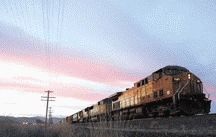GEOGRAPHY OF SOUND
Published 12:00 am Wednesday, August 22, 2007

- (File photos).
– Ethan Schowalter-Hay
The Observer
Professor Marian Mustoe, who comprises the entirety of the Geography Department at Eastern Oregon University, likes to emphasize the breadth and variety of his discipline.
"The stereotype that the study of geography is nothing more than the rote memorization of place names on maps is still strong amongst many college students as they begin a geography course at the collegiate level," he writes on his website.
Mustoe has been trying to incorporate a more robust field component to his curriculum. Summer semester, with its smaller classes and cooperative weather, is especially accommodating to this type of lesson plan.
His Cultural Geography class has about 120 students during the regular school year. In summer, he may be dealing with five or six.
"When you have a little tiny class like that, it makes a big difference," Mustoe says.
This season, Mustoe let his students loose with the directive to capture noises representative of La Grande aural snapshots of the town’s "soundscape."
"We were looking at the sensual element of spaciality, which is generally perceived of as visual," Mustoe explains. "But we were looking at sounds."
After all, the ambient noise of a given place certainly influences our perception.
"I wanted them to think esoterically about how sound characterizes space," he says.
Tape recorders in hand, students were asked to consider the following questions:
? How does a sound envelope define a space?
? Does sound have culturally spatial significance?
? What are some of the sounds that we perceive as defining La Grande?
The wide scope of the focus is reflected in the diversity of the results from industrial clanking to gurgling water.
Mustoe says the class tried to extract defining sounds from their recordings.
"We tried to find those ‘cameo’ sounds that came out of the soundscapes and defined them," he explains.
For example, the noises that seemed to define Les Schwab were the spinning of hubcaps and the whine of pneumatic air impact wrenches.
Scott Carter, a business major, recorded the bustle and lurch of the Boise Cascade lumber mill, where he’s worked as a millwright for years.
"I just followed (the logs) from beginning to end," he says.
"The sawing sound that’s the gang edger," he explains. "That’s probably one of the most defining sounds for a sawmill."
"I’ve been listening to that noise for 20 years."
In Crystal Madrigal’s soundscape, which encompassed the general area of her La Grande home, the hallmark sounds were those that often slip into the background for the average pedestrian: the moan of a Union Pacific engine, the ratchety hiss of omnipresent sprinklers, the gurgle of the public library’s landscaped waterfall.
"These are basically the sounds that make up La Grande," she says.
Her final analysis explored the definition of noise pollution do La Grande’s daily sounds qualify?
"It depends on the perspective of the person who’s listening," she says.
Mustoe set up a portable classroom studio where the class recorded narrations and assembled the podcasts.
He hopes students take away a different approach to perceiving landscapes.
"They’ve indicated the ambient sounds they hear on a regular basis will be heard now through different ears," he says.
"A personal goal for me was to get the students to think about their environment. Their sound environment, in this case."
Madrigal, who begins her final year in EOU’s elementary education program in the fall, says she certainly views the world through a different lens.
"I know now that when I go to the grocery store, that’s part of cultural geography," she says. "And when I hear the wind, I go back to thinking about the class."
Mustoe’s students this summer were Jessica Byrnes, Scott Carter, Parker Jones, Crystal Madrigal and Taylor Sauter.
Their recordings are preserved through Mustoe’s homepage, Acoustic Space, at http://www.eou.edu/~mmustoe/studentssounds.html.

